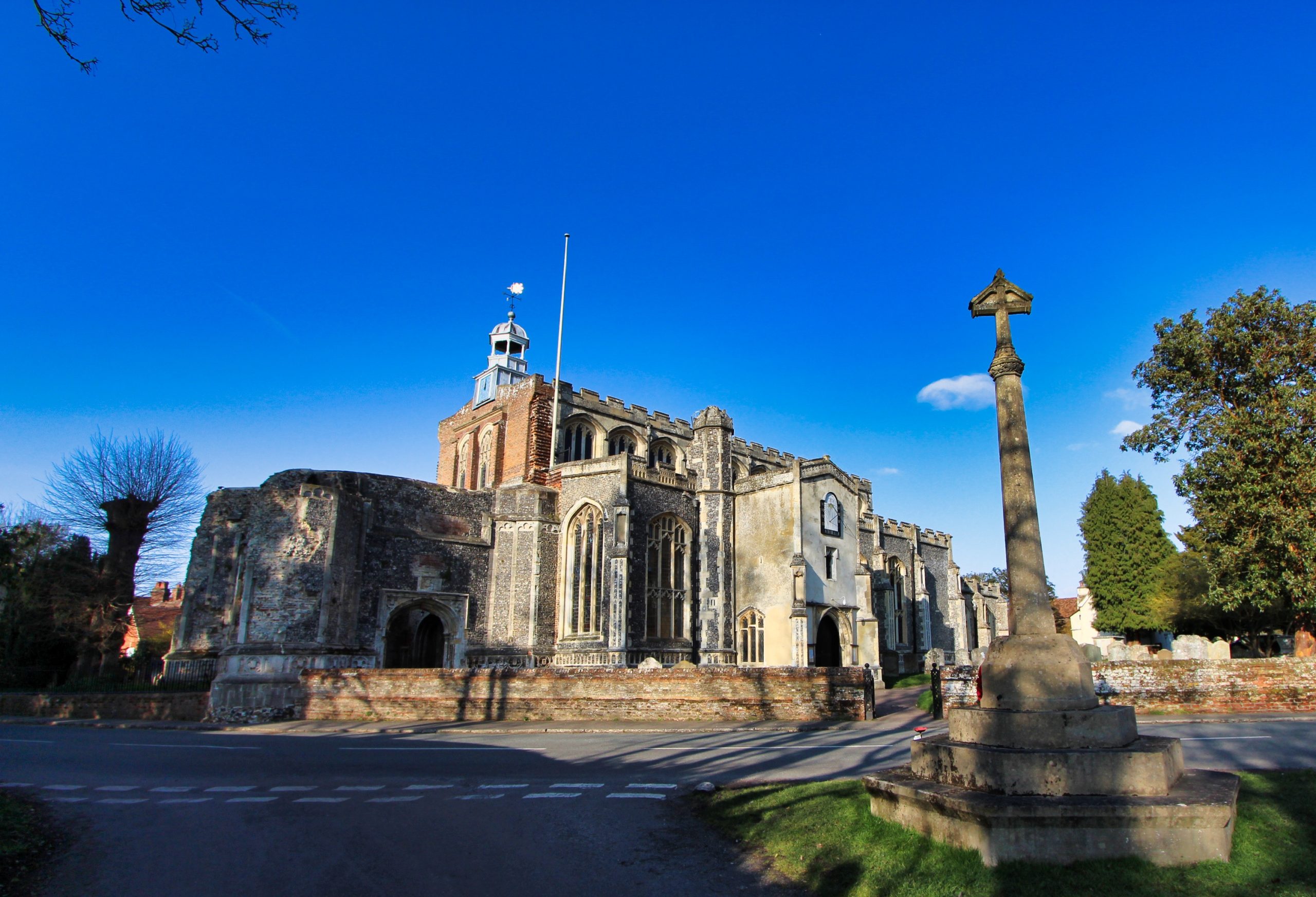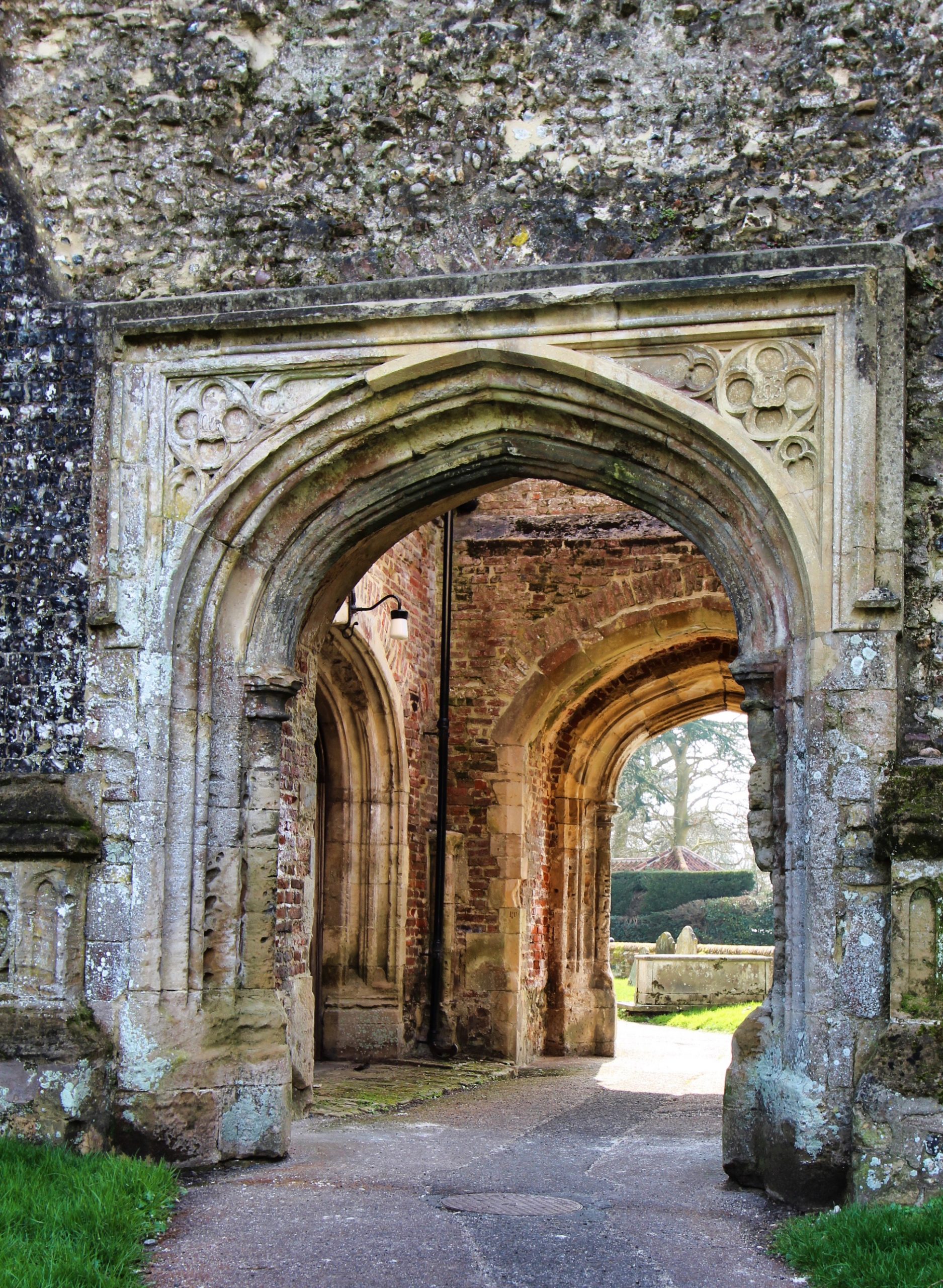Church of St Mary
Christians have worshipped here for over 1,000 years, however the church dates roughtly from 1350-1550, ;ate perpendicular in style, of stone and brick fragments from an earlier church.
It is 120 feet long, 56 feet wide and 45 feet hight (36.5 x 17 x 13 metres)
- 6
- Grade 1
- EB's Historic church in village centre. Dated C14 with the famous "part-finished" Bell Tower and bells housed in Bell cage
Local History
Exterior – On the South face beautiful East Anglian flintwork, with grades fo workmanship form the earliest irregular stones to be squared flings in regular courses (packed with flint chips called ‘gallitting’) round the tower base.
Tower – Begun in 1525, by tradition at the expense of Cardinal Wolsey, whose death in 1530 stopped the work through lack of funds.
West Door Inscription – Initial letters of Latin words: in English, For Holy Church John Fine, Francis (or Frederick) Yual and others made (this gift) in honour of Jesus and Mary.
South Porch – Priest’s room above, subject of a famous painting by John Constable, R.A. The pillars supporting seats almost certainly came from an earlier (14thC) building.
North Turret – Bears a star of ‘mullet’, emblem of the De Veres, Easrls of Exford, sometime lords of the principal manor and the then patrons of the living.
Churchyard – The Constable family tomb – last used in 1949 – is in the North East corner of the churchyeard near the Boiler House. The artist’s parents are here but Constable himself is buried in Hampstead cemetery in London.
The Grave of William Lott (of ‘William Lott’s House’) is located by the main path adjacent to the East end of the Lady Chapel.
Chanel and Crossing – Mid-14th century: the cross-wall either side of the chancel arch is the oldest part of the whole church. In the fifteenth century, the decorated capitals and arch were removed, and the North turret-stair built to the rood loft, a railed platform across the church where the top of the present screen reaches: here the Holy Communion gospel was read on festal days. Its bricked-up doorway is high up in the North East Corner of the Nave. About the same period, the two side-chapels were added. An interim classical screen and musicians gallery appear in a pencil sketch by Constable on the south aisle wall. The present chancel woodwork was designed by Sir T.G. Jackson.
In the North wall is an Easter Sepulchure recess depicting the Resurrection of Lord, with leaf decoration in a beautiful free hand arabesque pattern of the mid-fifteenth century. In is were laid the consecrated bread from the Maundy Thursday Holy Communion, and the Alter Cross-head on Good Friday, in token of His Burial, to be carried in procession to the altar on Easter morning in honour of His Ressurrection.
Beside it, a memorial to Maria, wife of John Constable: opposite, a fine alabaster acrostic monument with two well carved angels.
Form the Crossing can best be seen the West window by Mr Hugh Arnold (with the blue lion of Emmanuel Collage, Cambridge, the present patrols), and the ‘Good Shepherd’ memorial to a beloved Rector.
North Chapel – Now the clergy vestry and organ chamber, Outline of a Consecration Cross on its South Wall: others are on the North walls of the Chancel and South Chapel.
The organ was purchased in 1963 from St. Andrews, Gravesent where a new church warrented a new instrument. It was completely rebuilt – at ten time the purchase price of £250 – by Bishops of Ipswich and is generally considered to be in the ‘top twenty’ in Suffolk. For the technically minded there are two manuals with pedal board and, including the original trumpet which had been held in store until fitted in 1985, 25 speaking stops.
North Aisle – Fragments of the tomb of Anna Parket, died 1656, show a bear’s head and camels. Next, on a plain stone, the oldest inscription, possibly of the 15th century: What are thou art here reader see, in this pale glass what thou shall be, desprised wormes and putrid slime, then dust forgot and list in time – etc’
The memorial to John Mattinson ready ‘ Eleven years the beloved schoolmaster of this Town, and then unfortunately shott’ The Latin couplet means ‘He profited and pleased, mixed business with pleasure, to his pupils a terr and a delight’
Parish chest dated by the horned lock-plate about 1400 A.D.: the lid is a hollowed-out tree trunk, probably of poplar.
Centre Aisle – Brass (the only one apart from empty ‘matrices’) to Robert Alefounder, died 1639. From the centre aisle can best be appreciated the two hundred or so colourful pew kneelers made by many village ladies of the last 15 years.
South Chapel –A very fine oak screen, with carving typical of Suffolk. A pleasing series of ‘Works of Christian Mercy’ windows.
South Aisle – The World War 1 memorial has a good bronze of St. George and the Dragon. Centre window to John Constable, R.A. dised 1837, the local born artist, with his sketch of the Chancel and Sanctury in his time, and an engraving of Willie Lotts cottage at Flatford on the Stour. Note the undated by probably Victorian sketch of a possible tower – the implication being that completion of the towere was still being contemplated 300 years after Wolseys death.
West End – after 15 years ‘on the drawing board’, the re-development of the West End took place in 1991. The font – which stood int he middle of what is now the Meeting Room – was moved to its position near the South Door and four short pews were removed. Two choir vestries had been built in 1958, the one on the North side has become a ‘unisex’ vestry for all the choir while the other has been incorporated into the scheme.
With some thought going into furnishings, heating independent of the main church system, and a fair degree of soundproofing, we now have an area capable of seating 60 but which can be used, for example, for Sunday School classes concurrent with a service. Conversely the provision of three pairs of double doors means that the area can be opened up for additional seating at major services.
Details
Church has a C14 Chancel with some C15 alterations. North and south chapels mid C15 with later alterations. South aisle later C15, incorporating C14 south door. 1525 date-stone on tower. North aisle, clerestory and nave arcades c1530s – 40s. Restoration 1850s – 60s. Further alterations and additions of early C20 by T G Jackson. Perpendicular style. Tower of brick and flint faced with knapped flint. North aisle mainly brick with some septaria and roughly-dressed stone. South aisle brick and snapped flint. Later stucco to aisles, now removed. Ashlar clerestory. South porch and chancel rendered above plinth. Ashlar dressings throughout. Plain tile roofs. West tower with passage through, 5-bay aisled nave, south porch with parvise, 2-bay chancel with single-bay chapels to north and south. Tower: incomplete, raised only to single stage. 5-sided angle turrets, ashlar plinth with encircled quatrefoils containing shields. Much weathered flushwork above. Wide north and south arches to passage. 2-centred moulded arches on inner responds with continuously moulded jambs under square label containing encircled quatrefoil with shields and mouchettes to spandrels. Date plaque above south arch now illegible. Passageway retains vault shafts. West doors have linenfold panelling and enriched central baluster. West front has C20 paired traceried windows and is surmounted by C18 octagonal bellcote. South aisle: plinth, flush-work band, flushwork buttresses with niches and truncated pinnacles. Tudor-arched 3-light Perpendicular windows. Battlements throughout enriched with carved shields. South porch of 2 storeys with domed stair turret to west. Flushwork plinth and diagonal buttresses with niches. Pointed arch, the inner order on responds, with continuously moulded jambs enriched with shields. Hoodmould surmounted by square label with encircled quatrefoils and mouchettes in the spandrels. Single-light window to parvise under square label. Parapet. North aisle: plinth, flushwork offset buttresses with brattishing. Large 4-light windows with Perpendicular tracery. Polygonal 3-stage stair turret to east surmounted by finial, with the mullet device of the De Veres, Lords of the village manor of Old Hall from 1425. North door: linenfold panelling with central baluster in continuously moulded surround enriched with niches and shields. Square moulded surround with outer colonettes and decorated spandrels. Clerestory his 3-light segmental-pointed windows with Perpendicular tracery. Chancel and Chapels have 3-light windows with Perpendicular tracery. Diagonal buttresses to chancel and 5-light east window. Embattled parapets. Interior: nave arcade of 2-centred arches on piers of section four shafts and four hollows with moulded capitals to shafts. Pointed chancel arch on triple responds. Original roofs to south aisle and chancel. Nave roof of 1854. Angle corbels to south chapel, reroofed 1866. Easter Sepulchre with C15 wall painting. Wall monuments to William Jonar 1636, and to Edward Lambe d.1617 with niche containing kneeling figure flanked by angels and surmounted by entablature with hatchment and obelisks. Early C18 marble chest tombs to Chaplin and Parker families in south chapel. Memorials to Maria Constable, Wife of John Constable, and her grandfather Dr Rhudde.
Pevsner N, Suffolk 2nd Ed 1974 pp 195-196 Paterson T F, East Bergholt in Suffolk, 1923 pp 52-90. Riches A, Victorian Church Building and Restoration in Suffolk 1982 p 366. Elam J F, St Mary’s Church East Bergholt 1986.
- 6
- Grade 1
- EB's Historic church in village centre. Dated C14 with the famous "part-finished" Bell Tower and bells housed in Bell cage
- Historic England Reference: 1193803


